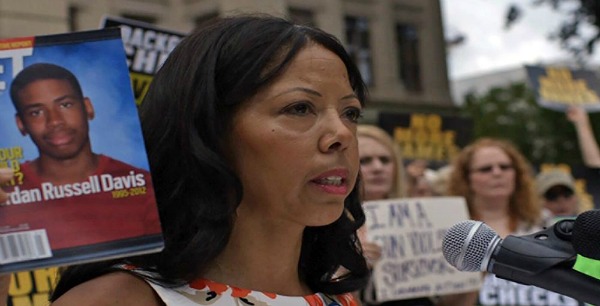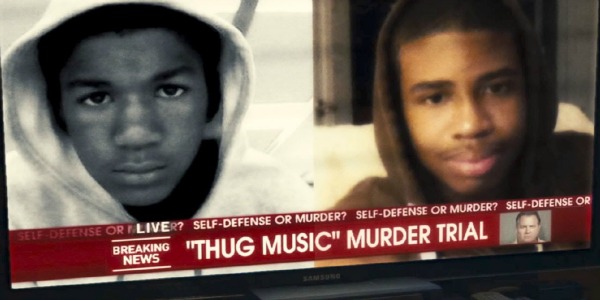3 1/2 MINUTES, 10 BULLETS: Something Has Got To Change

Becky spends her days working in TV and she spends…
On November 23rd 2012, 17 year old Jordan Davis was shot dead inside a friends car at a gas station. He was shot by Michael Dunn, a 43 year old white male, because of an altercation which began when Dunn asked Jordan and his friends to turn down their music. The situation escalated and a few minutes later Jordan Davis was dead.
There are stories like these coming out of the US on an almost weekly basis. In 2015, 1,134 black men were killed at the hands of white police officers. The shooting of Jordan Davis took place in 2012, before Ferguson and before the beginning of the Black Lives Matter movement and the film 3 ½ Minutes, 10 Bullets fully encapsulates the feelings of injustice, devastation and the need to change the systemic that were intrinsic to the following protests that spread out across the country only a year or so after.
Mark Silver’s 3 ½ Minutes takes place almost entirely inside the courtroom and inside the houses of Jordan’s parents, capturing the trial of Michael Dunn and the reactions of those surrounding Davis. It is a highly emotional documentary, one that clearly needed to be made. From beginning to end, we follow Dunn’s trial and watch as the prosecution and defence try to convince the jury that their version of events is what really went on. Woven into this narrative is underlying ideas about systematic racism, the failure of the legal system and the absurd gun laws which govern America.
A Sense of Isolation
By its nature, 3 ½ Minutes, 10 Bullets was always going to be quite limited with what they could and couldn’t capture on film. The gas station that the shooting occurred at had no CCTV footage, the filmmakers had incredibly limited access to the Dunn family (they refused to give interviews) and there was initially no guarantee that they would be able to film inside the courtroom.
Fortunately, the state of Florida allowed Silver and his team to film inside the courtroom providing they give the media access to the footage they shot inside. This allowed them to have full control over the shots used inside the courtroom, and also meant that they could use the CCTV camera footage within the courtroom to their advantage. There are some magnificent reaction shots and close-ups on both Dunn and Jordan’s friends whilst testifying, both of which would have been hard to accomplish without free reign over the filming.

Whilst most of the the film is told inside the court, there are some moments of heartbreaking rawness from both of Jordan’s parents. Together they are the heart of the film, two extraordinary characters who speak with brutal honesty throughout. Jordan’s father, Ron, in particular is an incredibly strong character from beginning to end. There are moments within 3 ½ Minutes where we realise that this film can simply be read as a film about grief. Neither Ron nor Lucia, Jordan’s mother, hold anything back. This must be attributed to the ease they felt around Silver, and the desire for their son’s story to be heard around the world.
Equally, interviews with Jordan’s friends feel very natural and unscripted. We are continually reminded through the background, the conversation and the way in which the boys speak that they are just children. There are several scenes in which we, the audience, and other people in the film are watching Youtube videos which Jordan and his friends made. Often they depict the boys pretending to rap to music, or driving around in the car – everyday occurrences for teenagers. These images are juxtaposed with Dunn and his lawyer telling the court that Jordan was a gangster, out to hurt people. The result is almost laughable – we can clearly see that Jordan was average teenager and although he may have a big mouth, it’s very obvious that he was no ‘gangster’.

There are a few times where the interviews begin to get a little invasive. When we watch Ron swimming from under the water, it feels very set-up and scripted – and the metaphor of ‘drowning in grief’ feels very heavy-handed. There is also an uncomfortable scene near the beginning of the film, with two of Jordan’s friends in a car. The point being made is obviously the connection between the shooting happening in a car and the boys being in a car now, but it really did nothing for the content of the interview, and again quite staged. I’m also quite unsure of the timeline throughout the film; there are interviews with Jordan’s friends several times where it is unclear how long it has been since the shooting occurred.
Symptomatic of America
At one point during 3 ½ Minutes, one of Jordan’s friends discusses at length the use of the word ‘thug’. Michael Dunn had remarked to his fiance a few moments before fatally killing Jordan, that he ‘hated that thug music’. This shooting was about race and everyone from Jordan’s parents, to his friends, to the protesters outside the court know it. But, as we find out later in the film, the court has ruled this shooting not to be a hate crime so they cannot discuss race within the court.
Silver makes it abundantly clear that this is about race. There is a heartbreaking but critically important scene where Ron talks about receiving a text message from Trayvon Martin’s father after the incident, welcoming him to ‘a club none of us want to be in’. The 17-year-old Trayvon Martin was shot and killed in in Florida in 2012. This short scene allows the audience to understand that this is not a singular incident, nor is this without a context of systematic racism. At this point, we understand that this film is not just about Jordan Davis – it’s about black lives everywhere.

3 ½ Minutes is concerned as much with racism as it is with the absurdity of America’s gun laws. Dunn’s entire defence is based on the ‘Stand Your Ground’ law and his lawyer reinforces that for Dunn to be innocent, Dunn merely had to perceive a threat – not for there to have actually been a threat. Dunn’s statement that if he hadn’t shot Jordan, then perhaps Jordan would have gone on to injure/shoot someone else in the future, perfectly encapsulates Dunn’s mental state and conviction of his own innocence.
Dunn and his family refused interviews with Silver, and so most of what we infer about Dunn comes from phone calls he makes to his fiance from prison. There is no doubt about it: Michael Dunn thinks he is the sole victim in this situation, and that he was within all of his rights to shoot Jordan Davis.
Silver himself talks at length about the connection of this sort of ‘pre-emptive crime’ in relation to recent wars in the Middle East. As Michael Dunn was so certain of the ‘clear and present threat’ (in his own words), so was America and the West certain of dangerous weapons, though we could not see them. Growing up governed by a system that advocates ‘Stand Your Ground’ for the entire country, it’s hard not to have some level of understanding of how this shooting (and others like it) are inevitable.
A Tragic End
Silver carefully utilises the space in Jacksonville, Florida to make the audience understand what an isolated place this is. He describes wanting to construct interviews on the street with passers-by to get the view on the shooting, but found that there was no-one out there to talk to. Everyone was in cars, or behind walls in gated communities. “Gas stations and malls are the only places where different types of people come together,” Silver explains. The same is true for Michael Dunn and Jordan Davis, where Dunn’s prejudices proceeded to overrule any rational thought.
So, instead of candid interviews with pedestrians, we watch aerial shots of endless roads, wide shots of tangled junctions with cars moving quickly on. It’s lonely and it’s depressing, but more fitting for a film that speaks volumes about human interaction. These cutaways remind us of the need to speak to one another, not to shut ourselves away from anyone who looks different from ourselves. To engage with and shut down systematic racism – something that Michael Dunn clearly could not do. This is a must-see film.
What do you think are the best films which showcase the flaws in the justice system? Do you think documentaries are better at exposing this, or dramas?
3 ½ Minutes, 10 Bullets premiered at Sundance 2015, and has been screened at numerous film festivals, and was broadcast on HBO. It received theatrical release in the UK in October, 2015.
Does content like this matter to you?
Become a Member and support film journalism. Unlock access to all of Film Inquiry`s great articles. Join a community of like-minded readers who are passionate about cinema - get access to our private members Network, give back to independent filmmakers, and more.
Becky spends her days working in TV and she spends every other minute writing about cinema, TV & feminism. Based in London, she also likes drinking gin, re-watching 'The X Files' and writing about on-screen representation and all manner of things over at femphile.com













